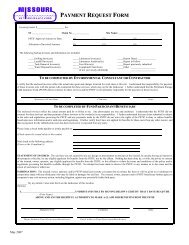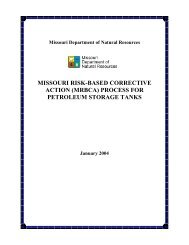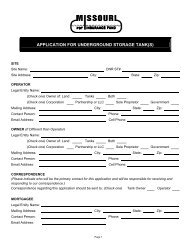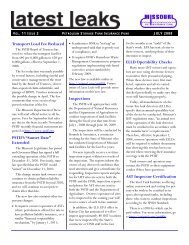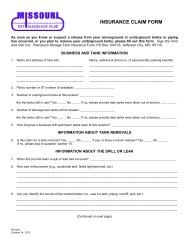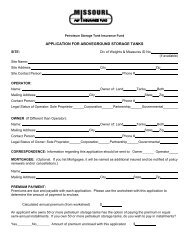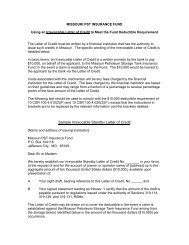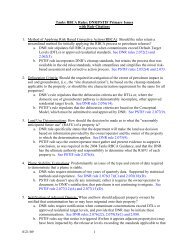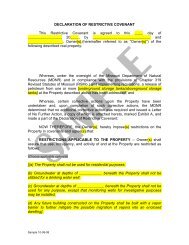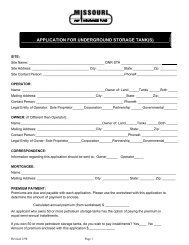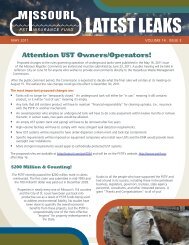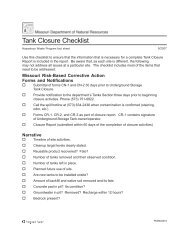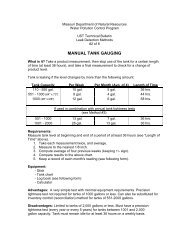Missouri Petroleum Storage Tank Insurance Fund Review of ...
Missouri Petroleum Storage Tank Insurance Fund Review of ...
Missouri Petroleum Storage Tank Insurance Fund Review of ...
Create successful ePaper yourself
Turn your PDF publications into a flip-book with our unique Google optimized e-Paper software.
Loss Projections for <strong>Missouri</strong> <strong>Petroleum</strong> <strong>Storage</strong> <strong>Tank</strong> <strong>Insurance</strong> <strong>Fund</strong>At the time the standards were implemented, about 1,500 claims were in the process <strong>of</strong>settlement. Some <strong>of</strong> these claims were settled under the old standard but the majoritywere settled under the new “risk based” standard.While it is difficult to say what the impact <strong>of</strong> the new standards will be, it might beexpected that claim settlement costs could be lower under the new standards sinceenvironmentally unnecessary work will not be necessary. Also, there is some concernthat claim settlement rates might decrease as claims remain open for longer periods asanalysis is taken to determine the amount <strong>of</strong> remediation necessary for the site.Even though the risk-based guidance has now been in effect for 3 1/2 years, it is stilldifficult to accurately gauge the impact <strong>of</strong> the standards on the overall costs <strong>of</strong> thesystem. There is little evidence that reserve adequacy or claim closure rates havechanged dramatically under the new system. However credibility issues prevent anaccurate measurement <strong>of</strong> the new standards.Data7. Actuarial MethodologyLoss data was developed from a transactional pull from Williams and Company claimssystems. Loss data was from inception until June 30, 2007. Data was analyzed on afiscal year basis. Revenue was generated from reports provided by the MPSTIF. Theseexhibits showed the transport fees, initial tank fees, and policy premiums.During the analysis <strong>of</strong> data, data was segregated into the type <strong>of</strong> policy(<strong>Insurance</strong>/Remedial) and the type tank (AST/UST). In addition, it was discovered thatdevelopment patterns for insured UST tanks differed by the cause <strong>of</strong> loss. For thepurposes <strong>of</strong> this report UST <strong>Insurance</strong> claims were divided into 3 separate subcategories:Closure, Release, and Sale/Other. Claims which were the result <strong>of</strong> a “Sale” appear todevelop much slower than other types <strong>of</strong> claims.Claim type was not credible for AST claims, and it not available for any remedial claims.Therefore, there are no breakouts for these types <strong>of</strong> claims.Summarizing the above classifications, data was analyzed for the following 6 categories:1. <strong>Insurance</strong> UST claims – Closure2. <strong>Insurance</strong> UST claims – Sale/Other3. <strong>Insurance</strong> UST claims – Release4. <strong>Insurance</strong> AST claims5. Remedial UST claims6. Remedial AST claimsThe data was organized on a “report year” or “claims made” basis. The reason for this isthat there is not usually credible data on when a leak takes place.Kerper and Bowron LLCPage 9



